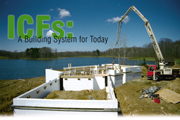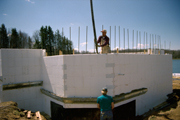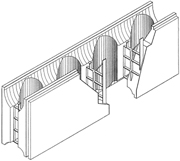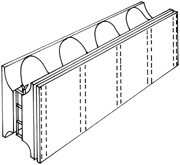

Most ICFs come in one of two types-flat wall and waffle grid. If one removes the flat wall form from the cured concrete inside, that concrete would be a continuous thickness or flat throughout. Removing a waffle grid form would yield a concrete block that is thicker in some places and thinner in others. It would resemble a waffle.
ICFs remain in place after the concrete wall has cured, providing interior and exterior insulation. The embedded tie has flanges on each side to create fastening strips for the installation of interior and exterior finishes. Brick, stone, vinyl and wood siding can be attached directly to the forms. Forms with recessed ties allow stucco and EIFS to be applied directly to the forms as well. Drywall, paneling and other interior finishes can be applied directly to most ICFs.

Uses and benefits
Either type of ICF is excellent for residential or commercial construction, depending on the situation. At first, ICFs were used primarily below grade for basement walls and foundations underneath wood frame construction. Gradually, as people began to understand the true benefits of ICF construction, ICFs were increasingly used for above-grade residential and light commercial construction. And ICF construction has now become so sophisticated that currently, an 11-story condominium building and an 8-story resort are under construction with infill walls using iForm, a flat wall form, produced by Reward Wall Systems, of Omaha, Neb. These two buildings are believed to be the tallest and the largest ever built in North America using ICFs.ICFs possess the following benefits:
Energy Efficiency: While ICF walls provide an excellent environment for basements, the full benefits of ICF walls are gained when used for the entire structure, above and below grade. ICF walls create a solid, continuous wall that blocks air infiltration, drafts, cold spots and wide temperature fluctuations. The insulated concrete walls provide a high R-value, very low infiltration of air, and thermal mass that keeps the temperature nearly constant throughout the year. As a result, heating and cooling units work far less to condition the inside air. The savings realized on heating and cooling costs can be more than 50 percent.
Clean Air: ICF construction is so tight that most manufacturers recommend using an air exchanger in conjunction with the HVAC systems. In blower door tests conducted by Reward Wall Systems, an ICF home tested at 0.0379 air changes per hour. Because so much unfiltered air leaks into a wood-frame house, the interior air of a typical new wood house changes completely .5 times per hour. Contrary to popular belief, it is easiest to control indoor air quality in a tight home. The air exchanger continually pumps fresh, filtered clean air into the heating and cooling system keeping the interior environment clean and comfortable throughout the house. This also means that the interior air in an ICF structure is virtually free of airborne dust, pollen and other allergens.
Sound Abatement: Solid concrete walls with several inches of EPS insulation make for quiet buildings. Riverbank Acoustical Laboratories of IIT Research Institute in Geneva, Ill., conducted sound transmission loss tests on 11-inch waffle grid forms with 1/2-inch drywall on both sides. A 7,412-pound sample wall was constructed in the laboratory's test frame and allowed to cure for 31 days.
The test consisted of transmitting sound ranging from soft to loud in volume. Instruments on the other side of the wall then detected how much sound got through to the other side of the wall. The wall measured a transmission loss of 49 dB according to the limits set by the ASTM Standard E90-97, thus giving the wall a sound transmission class rating of 49. By comparison, a 2x4 wood-frame wall filled with fiberglass insulation and with 1/2-inch drywall on both sides has a sound transmission class of 36. A sound transmission class of 50 is inaudible.
Safety: Because the concrete in ICF steel-reinforced concrete walls cures to a strength at least 50 percent stronger than conventionally poured concrete, ICFs are one of the stronger wall system when it comes to standing up to the elements. In fact, ICF buildings have survived intact after being hit by tornadoes with wind speeds reaching as high 250 mph.

Fire safety is another benefit of ICF construction. Most ICF walls carry at least the two-hour fire rating required by most code officials, but some ICF walls have been tested to three- or even four-hour ratings.


Report Abusive Comment